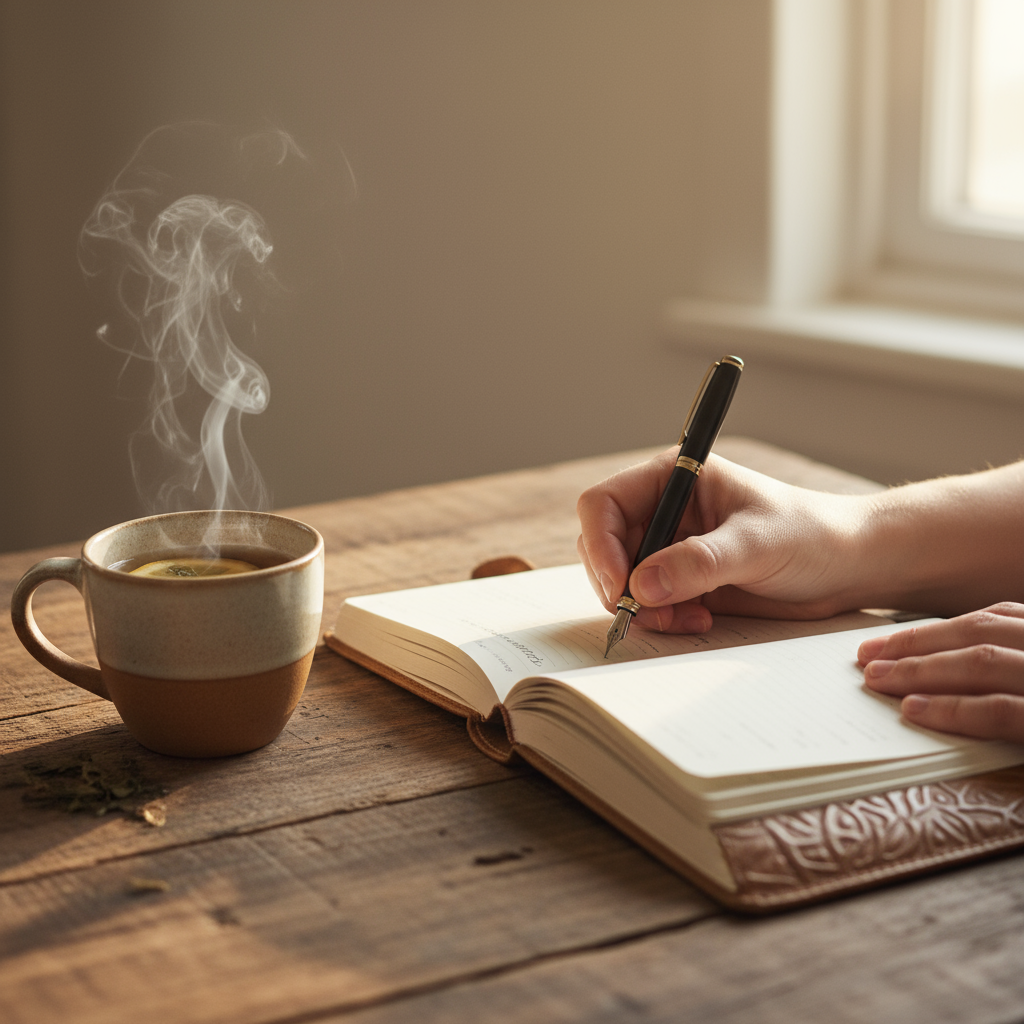
Table of Contents
Introduction
What if I told you there’s one simple practice that could completely change how you experience life? I’m talking about gratitude—and before you roll your eyes thinking this is just another feel-good fluff piece, hear me out. Gratitude isn’t some mystical concept that only works for eternally optimistic people. It’s actually backed by solid science, and the effects? They’re pretty incredible.
Think about the last time you felt genuinely grateful for something. Maybe it was your morning coffee hitting just right, or a friend texting you exactly when you needed it. That warm feeling you got? That’s your brain literally rewiring itself for happiness. Studies consistently show that people who practice gratitude regularly deal with less stress, sleep better, and yes—they’re genuinely happier. If you’re thinking “this sounds great, but where do I even start?” then exploring how to start journaling might be your perfect entry point. There’s something powerful about putting pen to paper and capturing those moments of thankfulness. And since stress has a sneaky way of clouding our ability to see the good stuff, learning about effective stress reduction methods can help clear the mental space you need for gratitude to flourish.
Now, here’s where things get really interesting. Gratitude isn’t just a mental game—it affects your entire body. People who regularly practice gratitude report sleeping like babies, feeling less depressed, and even getting sick less often. Your immune system literally gets a boost from feeling thankful. Wild, right? This connects perfectly with what we know from mental health awareness facts about how positive emotions can be genuine game-changers for our daily challenges. And if you’re already taking care of your body with something like the approach outlined in plant based diet benefits, you’re creating the perfect foundation for gratitude to work its magic.
The beauty of gratitude is how it plays well with other wellness practices. It’s like the friend who makes everyone else in the group better. When you combine gratitude with mindfulness and emotional intelligence, you’re building serious mental resilience. Want to dive deeper? Check out these external resources on the mental health benefits of journaling and benefits of mindfulness meditation—they’ll show you how gratitude amplifies awareness and emotional strength. Plus, there’s fascinating research at nutrition and mental health that proves what you eat directly impacts how well gratitude (and all positive emotions) can take root in your life.
What You’ll Learn in This Guide
We’re going to cover everything you need to build a gratitude practice that actually sticks. No fluff, no unrealistic expectations—just practical, science-backed strategies that fit into real life.
- The Importance of Gratitude: We’ll dig into exactly how gratitude rewires your brain for happiness and why it’s considered a cornerstone of mental wellness. You’ll see the research that proves gratitude impacts everything from your relationships to your physical health.
- Practical Steps to Practice Gratitude: Get ready for actionable strategies you can start today—daily journaling techniques, ways to express appreciation that don’t feel awkward, and mindfulness exercises that naturally cultivate thankfulness.
- Overcoming Challenges: Let’s be real—sometimes gratitude feels forced or fake. We’ll tackle those skeptical feelings, emotional blocks, and the “this isn’t working” moments, plus give you expert strategies to stay consistent even when life gets tough.
- Maintaining Your Practice: This is where most people stumble, so we’ll focus on making gratitude a lasting habit. You’ll learn time management tricks, reminder systems, and how to weave gratitude into your existing routines so it becomes second nature.
Throughout this article, we’ll explore how gratitude connects with other life skills that matter. Things like time management skills and strategies to stay productive actually work better when you’re operating from a place of appreciation. When you’re grateful, you’re more present, more focused, and frankly, more pleasant to be around—which makes everything else in life flow more smoothly.
Whether you’re completely new to this or you’ve tried gratitude before and it didn’t stick, this guide meets you where you are. We’re not aiming for perfection here—we’re aiming for progress. Real, sustainable change that makes your days brighter and your relationships stronger.
Ready to see what happens when you consistently notice the good stuff in your life? Let’s explore how gratitude can transform not just your mindset, but your entire experience of being human. Because once you really understand how powerful appreciation can be, you’ll wonder why you waited so long to make it a priority.

Let’s talk about gratitude—not just the warm fuzzy feeling you get when someone holds the door open, but the real deal. The kind that can actually rewire your brain and transform how you experience life. Gratitude isn’t something that just happens to naturally optimistic people. It’s a skill. And like any skill worth developing, it takes practice, patience, and yes—sometimes a little creativity to make it stick. The beautiful thing? Once you figure out how to weave gratitude into your daily routine, it becomes this quiet superpower that influences everything from your stress levels to your relationships. We’re going to explore the most effective ways to build this practice and tackle those sneaky obstacles that can derail even the best intentions.
Effective Ways to Practice Gratitude in Daily Life
Here’s the thing about gratitude practices—they’re wonderfully flexible. What works for your neighbor might feel completely wrong for you, and that’s perfectly okay. Daily gratitude journaling is probably the most popular starting point, and for good reason. There’s something powerful about putting pen to paper (or fingers to keyboard) and actually writing down what you’re thankful for. It forces your brain to actively hunt for the good stuff, even on those days when everything feels like it’s going sideways.
But here’s what makes journaling really effective: specificity. Instead of writing “I’m grateful for my family,” try “I’m grateful for the way my sister texted me that ridiculous meme at exactly the moment I needed a laugh.” See the difference? The details make it real. Plus, when you look back through your entries months later, you’ll have this incredible collection of moments that might have otherwise been forgotten.
Now, if writing isn’t your thing, expressing gratitude to others might be more your speed. And I mean really expressing it—not just a quick “thanks” but taking the time to tell someone specifically how they’ve impacted your life. Send that text. Write that email. Have that conversation. You know what happens when you do this? Two things: you feel amazing, and you make someone else’s day. It’s like emotional compound interest.
Then there’s the mindfulness approach. Gratitude meditation techniques can feel a bit intimidating at first, especially if you’re new to meditation. But think of it less like sitting in lotus position humming and more like… mindful appreciation breaks. Five minutes in your car before work, focusing on three things you’re genuinely thankful for right now. The warmth of your coffee. The fact that your car started. The podcast that made you laugh during your commute. Simple stuff, but it shifts your entire perspective.
Some people love structure—guided prompts, specific daily questions, apps that ping them reminders. Others prefer a more organic approach, mixing and matching methods as their mood or schedule dictates. The secret sauce? Consistency beats perfection every single time. Better to spend two minutes daily being genuinely grateful than to plan an elaborate practice you’ll abandon by February.
Key Aspects of Practicing Gratitude
Let’s break down what actually makes a gratitude practice effective:
- Journaling Regularly: It’s not just about writing—it’s about training your brain to notice the good stuff. When you make this a habit, you literally start seeing more positive things throughout your day.
- Expressing Appreciation to Others: This one’s a game-changer for relationships. When you make appreciation a practice, you’re not just being nice—you’re building deeper connections and creating a positive feedback loop.
- Mindfulness and Meditation: Think of this as gratitude with presence. You’re not just listing things you’re thankful for; you’re really feeling them, which amplifies the emotional benefits.
- Personalizing Practices: Cookie-cutter approaches rarely stick. The best gratitude practice is the one you’ll actually do, whether that’s voice memos while walking the dog or gratitude photos on your phone.
Getting these elements right sets you up for something more than just another self-help experiment that fizzles out. You’re building a sustainable practice that can genuinely change how you experience daily life. But let’s be honest—knowing what to do and actually doing it consistently? That’s where things get interesting.
Overcoming Challenges and Maintaining a Consistent Gratitude Practice
Okay, real talk time. You start strong with your gratitude practice. Week one is amazing. Week two, pretty good. Week three? You forgot to do it twice, and now you’re beating yourself up about it. Sound familiar? You’re not alone. The gap between knowing gratitude is good for you and actually making it a lasting habit is where most people get stuck.
The forgetting problem is probably the biggest culprit. Life gets busy, routines get disrupted, and suddenly your beautiful gratitude practice becomes another item on your guilt list. Here’s a simple fix that actually works: habit stacking. Attach your gratitude practice to something you already do religiously. Gratitude while your coffee brews. Three thankful thoughts while brushing your teeth. Appreciation moments during your lunch break. The trigger is already there—you’re just adding to it.
Then there’s the skepticism factor. Maybe you tried gratitude before and it felt forced or fake. Or you’re going through a genuinely difficult time and focusing on positives feels like toxic positivity. I get it. The key here is starting small and being real about it. You don’t have to be grateful for big, life-changing things. Sometimes it’s just “I’m grateful this traffic jam gave me time to finish this podcast episode” or “I’m thankful my neighbor brought in my packages.” Authentic gratitude, no matter how small, beats performative gratitude every time.
What about those really tough days when everything feels hard? This is where gratitude becomes less about feeling good and more about building resilience. You’re not looking for silver linings or pretending everything is fine. You’re training your brain to hold space for both difficulty and appreciation simultaneously. Maybe you’re grateful for a friend who listened, or for your own strength in getting through the day, or even for the simple fact that difficult emotions don’t last forever.
Community can be incredibly helpful here. Whether it’s sharing gratitude moments with family at dinner, joining an online group, or just having one friend you text your daily appreciations to—having witnesses to your practice creates gentle accountability. Plus, gratitude is contagious. When you share yours, you often inspire others to notice their own.
Key Strategies to Sustain the Habit
Here’s what actually works for keeping gratitude going long-term:
- Set Reminders and Rituals: Link gratitude to existing habits rather than trying to create entirely new routines. Your phone alarm, morning routine, or evening wind-down are perfect anchor points.
- Use Supportive Tools: Apps, journals, voice memos, gratitude jars—whatever makes the practice easier and more enjoyable for you. Technology should serve your practice, not complicate it.
- Practice Patience and Self-Compassion: You’ll miss days. You’ll have periods where it feels harder. That’s not failure—that’s being human. Restart without the self-judgment.
- Reframe Challenges Positively: This doesn’t mean pretending bad things are good. It means getting curious about what you can learn, how you can grow, or what support you can appreciate even in difficult times.

Here’s what I love about gratitude—it’s so much more than just saying “thanks.” It actually changes how you see the world. We’ve covered a lot of ground together, and by now you’ve seen how powerful this simple practice can be. Whether you’re jotting down three good things in a journal, telling someone you appreciate them, or just taking a mindful moment to notice what’s going well—you’re literally rewiring your brain for the better. Less stress, more happiness, better health. The best part? Your brain starts looking for the good stuff automatically, even when life gets tough.
Building a gratitude habit that sticks? That’s where things get real. You’ll hit bumps—maybe you’ll feel silly at first, or forget to do it for a week straight. (We’ve all been there.) But stick with it. The payoff is huge: better relationships, emotional resilience, and just feeling more at peace with life. And here’s a secret—it doesn’t have to be perfect. A quick “I’m grateful for my morning coffee” counts just as much as a deep reflection. Try connecting it to something you already do daily. Brush your teeth and think of one good thing. Simple.
Ready to take this further? I’ve got some great resources that’ll help you level up your practice. Check out these effective ways to practice gratitude for fresh ideas that’ll keep things interesting. Since stress can make gratitude feel impossible sometimes, these effective stress reduction methods will help clear mental space for appreciation to grow. Want to get better at understanding your emotions? This guide on how to improve emotional intelligence pairs perfectly with gratitude work. And if you’re struggling to maintain any new habits (not just gratitude), these proven productivity tips are game-changers. Got a partner? This relationship advice for couples shows how gratitude can strengthen your bond. Finally, if you love the journaling aspect, you’ll want to read about the mental health benefits of journaling—it’s amazing how writing things down amplifies gratitude’s effects.
Look, gratitude isn’t just some feel-good fluff. It’s a real tool that changes how you move through the world. You’ll see more clearly, appreciate deeper, and handle whatever comes your way with more grace. Whether you’re starting fresh or getting back into it after a break, you’ve got this. Every single moment you choose to notice something good—no matter how small—you’re building a life that’s brighter and more connected. So go ahead. Start today. Your future self will thank you.
Frequently Asked Questions
-
What if I find it hard to feel grateful?
- Start small by noticing simple, everyday positives. Allow gratitude to grow naturally without pressure, using tools like journaling prompts or mindfulness to ease into the practice.
-
How often should I practice gratitude?
- Daily practice is ideal for the most benefits, but even weekly reflections can improve well-being. Find a rhythm that fits your lifestyle and feels sustainable.
-
Can gratitude improve mental health?
- Yes, research shows gratitude reduces stress, enhances mood, and fosters resilience. It supports emotional and mental well-being when practiced consistently.
